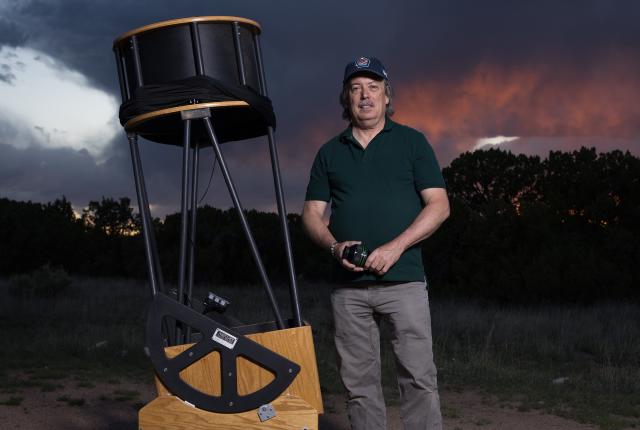AFTER 22 YEARS AS A GUIDE to New Mexico’s night sky, Peter Lipscomb remains enchanted with what he calls the most ancient of all natural beauties. A self-taught astronomer and award-winning astrophotographer, he founded Astronomy Adventures in 2002 and hosts the 2.5-hour trip into the Galisteo Basin on the Sky Railway StarGazer Train. Lipscomb volunteered to host New Mexico State Parks’ night sky programs 18 years ago and has held various roles since, including authoring Clayton Lake State Park and Dinosaur Trackways’ Dark Sky Place application and, most recently, preparing City of Rocks State Park’s application. The 62-year-old is forming a DarkSky New Mexico Chapter to spread appreciation for the night sky.
OBSERVING A TOTAL SOLAR ECLIPSE when I was eight years old was the most impactful thing that happened to me. When I was standing in the shadow of the moon during the 2017 eclipse, I was eight years old again.
Some people, when they’re really interested in astronomy, become astrophysicists. Outreach, education, and interpretation was how I was able to continue with astronomy. I’m spending time with others and sharing that sense of awe together.
When I came to New Mexico in 1996, my visiting family and friends would look up when the sun went down and go, “Wow!” Yeah, that’s the sky we have in New Mexico. I asked myself if there was a way I could connect people with what seems to be an unapproachable, strange place. That’s how Astronomy Adventures started.
I use a telescope called a reflector with a mirror that’s half a meter in diameter. There’s nothing about the design of a telescope that’s about magnification. It’s [about] aperture, or light-gathering ability. Think of those ancient photons as raindrops falling from a storm. The bigger the bucket you capture the rain in, the more you’ll catch. The bigger the telescope’s opening, the more photons you catch and the more distant objects you can see.
Spending time under the dark night sky—experiencing the timelessness, grandeur, majesty of our natural world, connecting to the time of our ancestors—is where I feel the most sense of fulfillment, serenity, wonder, and creativity. Seeing visitors’ excitement reminds me of what a special thing we have. When people gain some understanding about the nighttime environment, they want to start protecting it, too.



